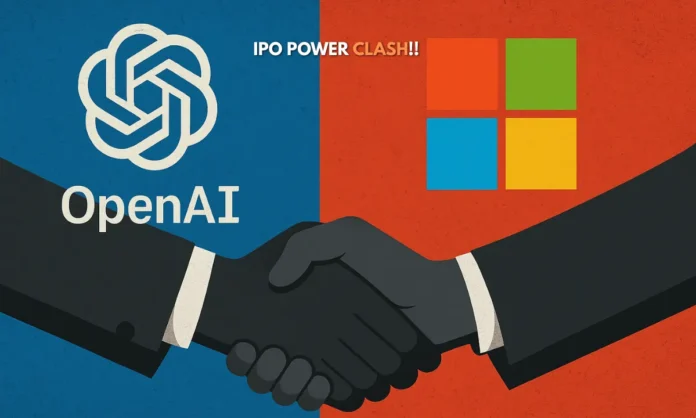Summary
- OpenAI and Microsoft are in high-stakes talks over restructuring their multibillion-dollar partnership ahead of OpenAI’s potential IPO.
- The dispute centers on Microsoft’s equity stake in OpenAI’s for-profit arm and continued post-2030 access to its AI technology.
- As OpenAI expands its enterprise ambitions, the two allies face growing competitive friction beneath their collaboration.
Behind the API: OpenAI and Microsoft’s Quiet Power Struggle
As OpenAI pushes toward a transformative IPO and restructures its corporate framework into a public benefit corporation (PBC), one of its biggest allies is also its most complicated negotiator: Microsoft. With more than $13 billion invested since 2019, Microsoft is not only OpenAI’s largest backer but also its most embedded enterprise partner. But now, the partnership is being tested like never before.
According to the Financial Times, the companies are deep into a renegotiation of their foundational contract. The issue at the heart of it all? Equity, access, and influence. Microsoft wants a long-term seat at the AI table. OpenAI wants flexibility to scale, raise capital, and run independently.
This is not an open break—but it’s far from smooth sailing. The deal that once powered Silicon Valley’s most synergistic alliance is now under stress from competing visions and rising ambitions.
“OpenAI and Microsoft are rewriting the terms of their multibillion-dollar partnership in a high-stakes negotiation designed to allow the ChatGPT maker to launch a future IPO” pic.twitter.com/0iICiNACeM
— Paul Roetzer (@paulroetzer) May 11, 2025
What’s at Stake: IP Access, Equity, and a 2030 Deadline
- Microsoft seeks to extend access to OpenAI’s models and IP beyond 2030.
- In return, it’s reportedly willing to take a smaller equity slice in OpenAI’s new for-profit PBC structure.
- The original 2019 deal gave Microsoft preferential IP access and a revenue share from product sales.
- OpenAI needs a flexible structure to go public and scale large AI infrastructure like Project Stargate.
The 2019 agreement gave Microsoft a long-term edge—preferential access to all OpenAI tech and a share of revenue until 2030. But in the age of rapid AGI development and trillion-dollar AI infrastructure plans, those terms now feel outdated.
Microsoft reportedly wants to renegotiate to ensure continued access to OpenAI’s AI models and codebase beyond 2030. In exchange, it may forgo some equity rights in the newly spun-off for-profit PBC that OpenAI aims to create—an entity that could be IPO-ready within years.
For OpenAI, the goal is autonomy. With partnerships brewing with Oracle, SoftBank, and even direct enterprise clients, the startup needs a structure that allows independence—financial, operational, and strategic. But Microsoft’s money and compute still power OpenAI’s biggest breakthroughs. This creates a delicate dance of dependency and divergence.
“Be Happy to Be on the Ride”: Corporate Culture Clashes
- A senior Microsoft employee said OpenAI treats it like a silent partner—just funding and compute, nothing more.
- The relationship has shifted from partnership to power tension as OpenAI courts other enterprise clients.
- Both sides acknowledge friction but want the conversion to succeed.
Tensions are growing not just from balance sheets—but boardrooms. A Microsoft insider told FT: “OpenAI says to Microsoft, ‘give us money and compute and stay out of the way.’” The sentiment reflects a cultural gap—OpenAI wants to move fast and break things, while Microsoft has enterprise scale and predictability at its core.
The awkward co-dependence is further strained by OpenAI’s growing ambition to compete in the same enterprise arena as Microsoft. From ChatGPT Enterprise to partnerships on the $500 billion Project Stargate, OpenAI is becoming more than just Microsoft’s AI supplier—it’s edging toward becoming a rival.
Still, sources close to both sides insist the relationship isn’t fractured beyond repair. “There’s a tough negotiation,” one source said. “But we’re confident we’ll get it done.”
IPO Pressure and the PBC Puzzle
- OpenAI’s shift to a Public Benefit Corporation structure is designed to allow an IPO.
- Microsoft’s stake must be clarified for public listing and shareholder disclosures.
- The IPO could redefine AI’s capital structure in Silicon Valley—and reset AI investment norms.
OpenAI’s decision to become a Public Benefit Corporation is not merely symbolic—it’s a strategic bridge to an IPO. But that pathway is legally and financially complex. Key among those complexities: determining how much Microsoft owns, what access it has post-IPO, and whether it remains the dominant institutional force behind OpenAI’s tech pipeline.
The PBC model allows OpenAI to pursue profit while legally embedding its mission to ensure AGI benefits “all of humanity.” But it also complicates how investor control, board composition, and profit-sharing are structured.
The resolution of this negotiation may set a precedent for how advanced AI firms structure power-sharing between mission, market, and mega-investors.
Beyond Contracts: A New Phase in AI Power Politics
OpenAI and Microsoft remain two of the biggest players in the AI revolution, but their alliance is entering a more transactional, more strategic era. Their partnership, once built on vision and trust, is now defined by commercial realities, equity tables, and product roadmaps.
The outcome of these negotiations will influence not just the structure of OpenAI’s IPO—but the very architecture of power in the global AI industry. In the race toward AGI, control of access, compute, and capital may matter as much as the algorithms themselves.


